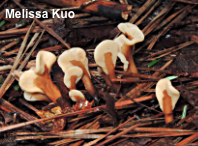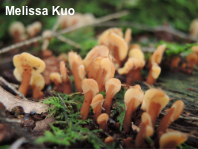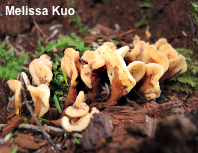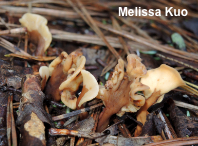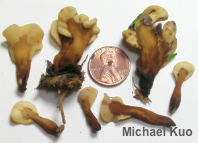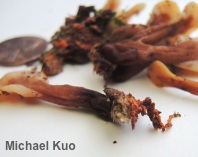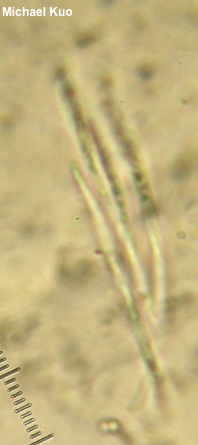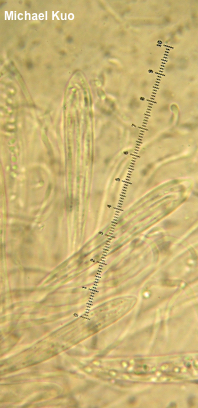| Major Groups > Clubs & Corals / Oddballs & Misfits > Spathulariopsis velutipes |

|
Spathulariopsis velutipes [ Ascomycota > Rhytismatales > Cudoniaceae > Spathulariopsis ... ] by Michael Kuo I think Spathulariopsis velutipes and the similar Spathularia flavida look like claymation characters in a kids movie about kitchen utensils. Though they can be difficult to distinguish from each other, these two species are not likely to be confused with anything else in the mushroom world; the flattened, clearly distinct, spatula-like head that descends the stem on either side is very distinctive. Unlike Spathularia flavida, Spathulariopsis velutipes has a minutely fuzzy, dark brown stem, and bright orange mycelium; Spathularia flavida has a pale stem and white mycelium. Spathularia velutipes is a synonym. Ge and collaborators (2014) provide convincing support for placement of Spathulariopsis, along with species of Cudonia like Cudonia circinans, in the genus Spathularia, but the authors stop short of official taxonomic transfers. Description: Ecology: Saprobic; growing gregariously or in clusters on the well-decayed wood of eastern hemlock—or on the ground around hemlock stumps and logs; sometimes reported (possibly erroneously) under other conifers besides hemlock; summer and fall; distributed east of the Great Plains, especially where hemlocks occur. Originally described from Vermont. The illustrated and described collections are from Michigan and Ohio. Fruiting Body: Roughly spatula-shaped, with a flattened head portion at the top of a stem, usually running down the stem on either side of it. Head 5–25 mm across; 10–30 mm high; dull yellowish; bald and often somewhat wrinkled; moist when fresh. Stem 20–40 x 3–8 mm; more or less equal above a slightly enlarged base, or slightly constricted just below the head; bald and pale toward apex, but dark brown and very finely fuzzy below; becoming hollow; attached to bright orange mycelium. Flesh insubstantial; brownish. Odor not distinctive. Chemical Reactions: KOH negative on head and stem. Microscopic Features: Spores 40–55 x 1–2 µm; aciculate; often slightly curved; smooth; hyaline and multiguttulate in KOH. Asci 70–120 x 8–15 µ; fusiform; hyaline in KOH. Paraphyses 70–150 x 1–4 µm; cylindric; flexuous; apices rounded, or subclavate; often curving, hooking, or curling past the asci; smooth; hyaline in KOH. REFERENCES: (Cooke & Farlow, 1883) Maas Geesteranus, 1972. (Cooke, 1883; Saccardo, 1889; Mains, 1955; Smith, Smith & Weber, 1981; Phillips, 1991/2005; Lincoff, 1992; Barron, 1999; Roody, 2003; McNeil, 2006; Miller & Miller, 2006; Wang et al., 2002; Raymundo et al., 2012; Ge et al., 2014; Kuo & Methven, 2014; Baroni, 2017; Woehrel & Light, 2017; Elliott & Stephenson, 2018; Sturgeon, 2018.) Herb. Kuo 09130403, 09121003, 07191502, 07151609. This site contains no information about the edibility or toxicity of mushrooms. |
© MushroomExpert.Com |
|
Cite this page as: Kuo, M. (2019, April). Spathulariopsis velutipes. Retrieved from the MushroomExpert.Com Web site: http://www.mushroomexpert.com/spathulariopsis_velutipes.html |
